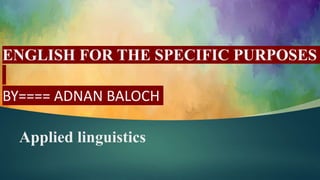
English for specific purpose
- 1. Applied linguistics ENGLISH FOR THE SPECIFIC PURPOSES BY==== ADNAN BALOCH
- 2. Introduction: English has become the internationally accepted language of almost all fields of knowledge. Therefore, in some cases, people in English need to be taught to handle specific jobs. To fulfill the needs of these learners, specific courses were designed and introduced. English for a specific purposes (ESP) is one of these specific courses.
- 3. Background: ESP emerged in the 1960s and become one of the prominent areas of EFL teaching. ESP is a learning-centered approach. Definitions: According to Strevens (1977) "ESP concerns the emergence of several activities, movements, and subjects that are carried out prominently(though)not exclusively in English across the world". Hutchinson and Waters (1992) Emphasize: "ESP to be an approach and not a product which means language learning, not language use in highlighted". Coffey (1985) observes that:- "ESP is a quick and economical use of the English language to pursue a course of academic study(EAP)or effectiveness in paid employment(EOP).
- 4. Main reasons for the emergence of ESP There are three main reasons for the emergence of ESP: • World war II • Development in educational psychology • Need analysis
- 5. Types of ESP: David Carter (1983) identifies three types of ESP: English as restricted language English for academic and occupational purposes English with specific topics
- 6. 1- The absolute characteristics are those ESP courses which are: Designed to meet the specific needs of the learner. Related in content to particular disciplines or occupations. Centered on language specific to those disciplines or occupations. In contrast to general English. Characteristics: According to Strevens (1988): There are two of characteristics of ESP . 1 - Absolute characteristics 2 - Variable characteristics 2- The variable characteristics are those courses Which may be restricted in the skills to be learned not to be taught according to a particular methodology.
- 7. Branches of ESP: Conventionally ESP has two main divisions. English for academic purpose: The purpose of EAP curriculums is to assist learners in developing particular study skills. Such that • Listening to academic course • Making presentations • Writing academic texts • Composing reports in specific academic premises, stay in contact with their recent researchers. English for occupational purpose: The purpose of English for occupational use is to address the employees related to their environment. It can be: • Pre-professional • Post-professional
- 8. Common features: • Authentic materials • Purpose related orientation • Self-direction Common abbreviations:- • EFL: English as a foreign language • ESP: English for specific purposes • EAP: English for academic purpose • ELP: English for legal purpose • ESW: English for social work.
- 9. Significant questions for ESP What is ESP in teaching? How do you manage to successfully teach in ESP? What is need analysis in ESP? What is ESP course design? What are the factors affecting ESP course Design? What is ESP methodology? ELT is an umbrella term and ESP is a part of it.
- 10. Qusestions! Q1: what is ESP in teaching? ESP for specific purposes is a subset of English as a second or foreign language. It usually refers to teaching the English language to university students or people already in employment, with reference to the particular vocabulary and skill they need. Q2: how do you manage to successfully teach in ESP? The responsibility of the teacher in ESP: Organizing courses Settings goals and objectives. Creating a learning environment. Evaluating students. Interest in learning. Subject-content knowledge. Learning strategies.
- 11. Qusestions! Q3: What is the need for analysis in ESP? Need analysis can be a vital asset for teachers of English for the specific purpose to identify their learner's key requirements or needs and determine the areas in which they are lacking skills. Q4: what is ESP course design? Course design refers to the planning and structuring of a course to achieve the needed goals. It is the outcome of several elements, the result of the need analysis, the course designer's approach to syllabus and methodology, and existing materials. (Robinson: 1991)
- 12. Qusestions! Q5: What are the factors affecting ESP course design? Language description Learning theories Need analysis The interdependence of these factors in the course design process is very important. The course design must bring the leader into play at all stages of the design process. Q6: what is ESP methodology? Most ESP courses assume some basic knowledge of that language system. ESP is centered on the language appropriate to these activities in terms of grammar, lexis, register, study skills, discourse and genre.
- 13. How is ESP different from English as a second language (ESL) also known as general English? The most important difference lies in the learner and their purposes for learning English. ESP students are usually adults who already have some acquaintance with English and are learning the language to communicate a set of professional skills and to perform particular jobs related to an assessment of purposes and needs and the functions for which English is required. Role of teacher An ESP teacher should: Set goals and objectives Organize courses Prepare material Evaluate students
- 14. Conclusion: The English for specific purposes has emerged as a significant field in applied linguistics. It is mostly concerned with the learners needs for a specific field of academics or occupation. References:- 1. T. Hutchinson & a. Waters (1987) ESP: a learning-centered approach. Cambridge university press and technology. 2. P. Strevens (1988) ESP after twenty years: a re-appraisal.